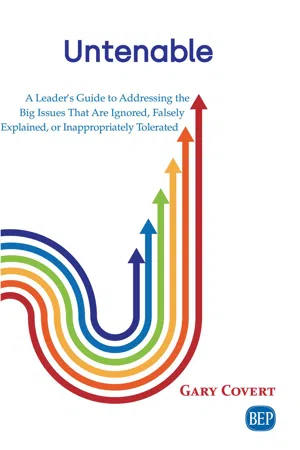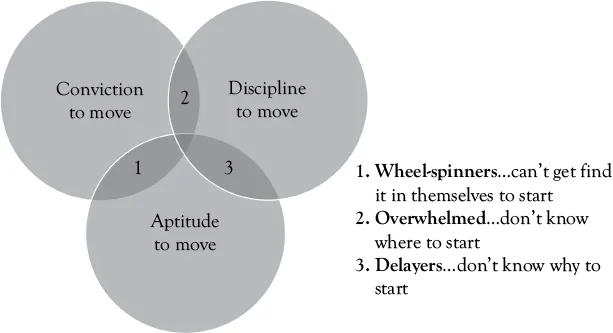
Untenable
A Leader's Guide to Addressing the Big Issues That Are Ignored, Falsely Explained, or Inappropriately Tolerated
- 128 pages
- English
- ePUB (mobile friendly)
- Available on iOS & Android
Untenable
A Leader's Guide to Addressing the Big Issues That Are Ignored, Falsely Explained, or Inappropriately Tolerated
About This Book
Untenable helps identify untenable situations, describes the barriers to addressing them, and suggests novel ways to approach them.
Even the best of us can find ourselves enduring situations that are negative and unsustainable. Too often, we ignore the situation or just make incremental moves. The boiling frog considers installing a ceiling fan. The deck chairs are arranged on the Titanic.
High-performing people can boost their own performance even further by developing their skills to identify and remove their untenable situations. Untenable situations at best sap our creativity, vitality, and energy, at worst; they can be serious threats to our well-being or health of our organizations. Untenable helps identify untenable situations, describes the barriers to addressing them, and suggests novel ways to approach them. This book is perfect for leaders who would like to be even more effective, see that effectiveness cascade into better organizational results, and would like to see their businesses grow. The author describes what untenable situations are, what they look like for leaders and organizations, and why we do not address them appropriately.
The book contains useful and practical insights for leaders to help coach themselves and others to identify their untenable situations, remove barriers that may be preventing those situations from being addressed, and prevent untenable situations from occurring in the first place.
Frequently asked questions
Information
- Anatomy of untenable situations
- Stuffed in the closet and swept under the rug
- Only for underperformers—not
- Getting real—the issue behind the issue
- A business owner might be putting off a decision about quitting a business that hasn’t performed in years
- An executive runs around like 13 “priorities” is normal, can be handled, and that things will be different from the results from last year
- A leader knowing that a high-level person is not working out (even the janitors know it is not working out), but no action is being taken
- A person feeling frustrated and anxious trying to perform well in a job they fundamentally do not enjoy
- A person experiencing health issues like extreme obesity or a two packs a day smoking habit
- The government reports that funds set aside for social benefits are soon to be depleted, but no politician is forthcoming with a rational plan to address
- Lack of a safety culture taken seriously by senior leaders
- Organizations that cannot deliver on promises after a big acquisition
- Organizations facing new competition with old thinking and hubris
- Organizations that cannot attract, develop, or retain exceptional talent
- An organization led by leaders with weak ethics.
- Acting in a disrespectful way
- Vacillating on important decisions
- Trying to please everyone
- Impulsive decision-making
- Isolating oneself from new information or key trends
- Chronic overeating and no exercise when on the road
- Not stretching after exercise
- Looking for blame and not cause

Table of contents
- Cover
- Halftitle
- Title
- Copyright
- Abstract
- Contents
- 01_Chapter 1
- 02_Chapter 2
- 03_Chapter 3
- 04_Chapter 4
- 05_Chapter 5
- 06_Chapter 6
- 07_Chapter 7
- 08_Chapter 8
- 09_Chapter 9
- 10_Chapter 10
- 11_ATA
- 12_Index
- 13_Adpage